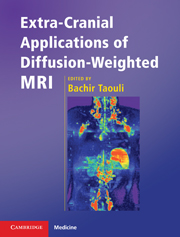Book contents
- Frontmatter
- Contents
- List of contributors
- Preface
- 1 Basic physical principles of body diffusion-weighted MRI
- 2 Diffusion-weighted MRI of the liver
- 3 Diffusion-weighted MRI of diffuse renal disease and kidney transplant
- 4 Diffusion-weighted MRI of focal renal masses
- 5 Diffusion-weighted MRI of the pancreas
- 6 Diffusion-weighted MRI of the prostate
- 7 Breast applications of diffusion-weighted MRI
- 8 Diffusion-weighted MRI of lymph nodes
- 9 Diffusion-weighted MRI of female pelvic tumors
- 10 Diffusion-weighted MRI of the bone marrow and the spine
- 11 Diffusion-weighted MRI of soft tissue tumors
- 12 Evaluation of tumor treatment response with diffusion-weighted MRI
- 13 Diffusion-weighted MRI: future directions
- Index
- References
1 - Basic physical principles of body diffusion-weighted MRI
Published online by Cambridge University Press: 10 November 2010
- Frontmatter
- Contents
- List of contributors
- Preface
- 1 Basic physical principles of body diffusion-weighted MRI
- 2 Diffusion-weighted MRI of the liver
- 3 Diffusion-weighted MRI of diffuse renal disease and kidney transplant
- 4 Diffusion-weighted MRI of focal renal masses
- 5 Diffusion-weighted MRI of the pancreas
- 6 Diffusion-weighted MRI of the prostate
- 7 Breast applications of diffusion-weighted MRI
- 8 Diffusion-weighted MRI of lymph nodes
- 9 Diffusion-weighted MRI of female pelvic tumors
- 10 Diffusion-weighted MRI of the bone marrow and the spine
- 11 Diffusion-weighted MRI of soft tissue tumors
- 12 Evaluation of tumor treatment response with diffusion-weighted MRI
- 13 Diffusion-weighted MRI: future directions
- Index
- References
Summary
Introduction
The possibility of sensitizing nuclear magnetic resonance (NMR) signals to molecular diffusion was recognized in the early, pioneering days of NMR by Hahn, Carr and Purcell. In the 1960s, the Stejskal–Tanner pulse sequence for measuring diffusion properties was introduced and has been a mainstay of diffusion NMR every since. The Stejskal–Tanner sequence is also the prototypical pulse sequence for diffusion-weighted imaging (DWI), although for human imaging there are a number of variants and alternative sequences that help manage the practical challenges of clinical scanning.
Until recently, DWI in humans has been dominated by brain applications, to a large degree because the relatively long transverse relaxation times (T2) in the brain help maintain a sufficient signal-to-noise ratio (SNR) and the good field homogeneity helps minimize imaging artifacts. However, recent improvements in scanning hardware and pulse sequence design have now made feasible good quality DWI for the body, and body applications are becoming increasingly common.
In this chapter, we review the basic physical principals of DWI, emphasizing issues particularly pertinent to body applications. We begin with diffusion NMR physics, covering both the relevant concepts of molecular diffusion and the essential theory for the Stejskal–Tanner pulse sequence. We will consider practical aspects of image acquisition, such as sequence selection and artifact reduction. The analysis of DWI data and an overview of selected important body applications will be discussed.
Diffusion NMR physics
Molecules within a liquid move in a complicated pattern that can be regarded as a random process.
Information
- Type
- Chapter
- Information
- Extra-Cranial Applications of Diffusion-Weighted MRI , pp. 1 - 17Publisher: Cambridge University PressPrint publication year: 2010
